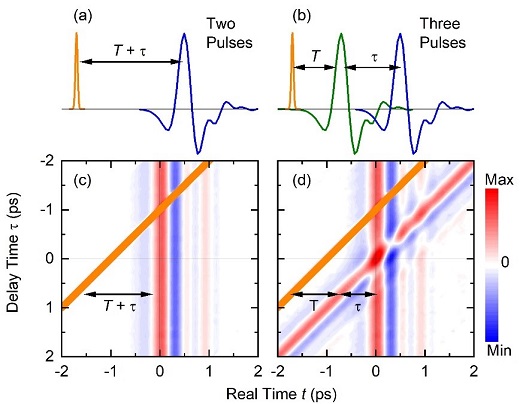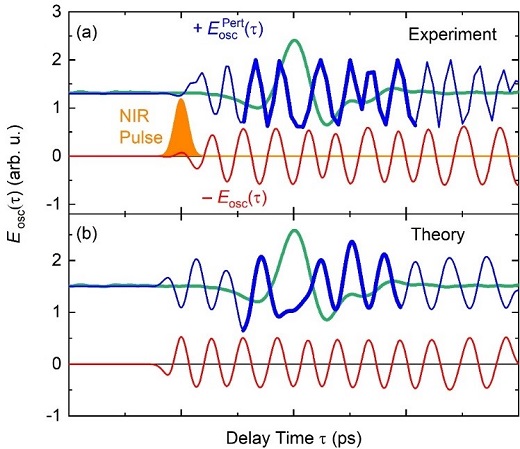by Forschungsverbund Berlin e.V. (FVB)

Fig. 1. (a,b) Two- and three-pulse sequences with a near-infrared pulse generating electrons (orange), a THz probe pulse (blue), and a perturbing THz pulse (green). The pulses are shown along the real-time axis t. The time interval T is the waiting time, the time interval τ the delay time. In the two-pulse sequence, the perturbing THz pulse is absent. (c) Contour plot of the probe pulse ECePr (t,τ) as a function of real time t and delay time t. The diagonal orange line indicates the temporal position of the near-infrared pulse. (d) Contour plot of the electric field ECeboth (t,τ) containing both the perturbing THz pulse (diagonal trace) and the THz probe pulse (vertical trace). Credit: Physical Review Letters (2023). DOI: 10.1103/PhysRevLett.131.166902
Researchers at the Max-Born-Institute have now mapped the linear and nonlinear optical polaron response using ultrafast two-dimensional spectroscopy in the THz frequency range. As they discuss in the current issue of Physical Review Letters, multi-photon ionization of isopropanol molecules by a femtosecond pulse in the near-infrared generates free electrons and the resulting changes of the dielectric properties of the liquid are probed and/or manipulated in the THz frequency range.
An electron and the surrounding cloud of solvent dipoles couple through electric forces and can undergo joint collective motions. Such many-body excitations in the terahertz (THz) frequency range are called polarons and have remained nearly unexplored so far. New results from ultrafast THz spectroscopy demonstrate the generation and manipulation of coherent polaron oscillations in a time range of 100 ps and beyond, thus enabling the control of dynamic electric properties of polar liquids.
Ionization of a polar liquid by intense light or particle beams generates free electrons, which relax on a picosecond timescale (1 ps = 10-12 s) into a localized ground state. The relaxation process includes the reorientation of the surrounding dipolar solvent molecules and the dissipation of excess energy.
In this way, an oriented molecular cloud is formed, which screens the charge of the electron. While extensive experimental and theoretical work has established a single-particle picture of the so-called solvated electron, the collective polaron behavior of the electron and its surrounding solvent cloud is not well understood.

Fig. 2. Polaron oscillations of solvated electrons in the alcohol isopropanol. The oscillatory THz electric field generated in the sample is plotted as a function of delay time (cf. Fig. 1). (a) Experimentally observed oscillatory field -Eosc(t) without external perturbation (red transients) and oscillatory motions EPert/Osc (t) with external perturbation (blue transients). The thick blue lines mark the time range, in which the polaron oscillations are modified by the perturbing THz pulse, the latter shown as a green line. (b) Transients calculated by a theoretical model. Credit: Physical Review Letters (2023). DOI: 10.1103/PhysRevLett.131.166902
The relevant sequences of the near-infrared and one or two THz pulses are shown in Fig. 1(a, b). During electron relaxation into the localized ground state, collective polaron oscillations are launched impulsively. The oscillations modulate the dielectric function of the liquid and, thus, the electric field of a single THz pulse transmitted through the excited sample [Fig. 1(a, c) and Fig. 2(a)]. The oscillations persist for a surprisingly long time range extending beyond 100 ps, their frequency of 3.9 THz is determined by the electron concentration and the dielectric properties of the liquid.
Interaction with an additional THz pulse perturbs this oscillatory response [Fig. 1(b, d) and Fig. 2(b)], resulting in a marked change of the oscillation phase and frequency during the perturbation. The electric field of the perturbing THz pulse induces a non-resonant nonlinear polarization, acting on the polaron and changing the collective oscillations of electron and solvent cloud.
Left panel: Cartoon of fluctuating alcohol molecules around a solvated electron (green ball) performing concerted polaronic charge-density oscillations (hydrogen atoms in red, remaining molecule in blue) Right panel: after spatial averaging of the microscopic electric charge density one easily recognizes the collective spherical charge-density oscillations. The latter experience almost no damping during the first 100 picoseconds. Credit: Forschungsverbund Berlin e.V. (FVB)
The polaron oscillations are connected with modulations of space charge, leading to radial, i.e., longitudinal-size, oscillations of a spherical molecular cloud of nanometer extension, which screens the charge of the solvated electron. The periodic size change affects the macroscopic polarizability of the polaron, making it accessible to optical probing with a THz electric field.
The longitudinal character of the oscillations is essential for their weak coupling to other excitations of the liquid, which results in a weak damping of the coherent motions. Theoretical calculations within a continuum model, which is based on the local field model of Clausius-Mossotti, reproduces the observed phase modulations.
The results emphasize the importance of many-body interactions in polar molecular ensembles and open a perspective toward transiently steering and manipulating dielectric properties in polar liquids by external THz excitation.

